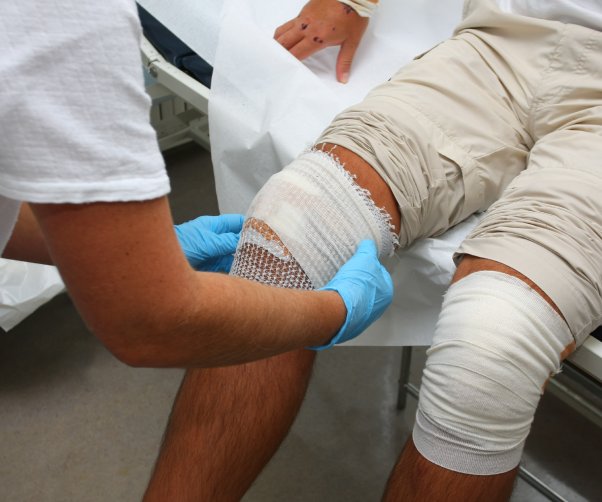
Caring for Wounds that Don't Heal
For most minor injuries, such as cuts or scrapes, some gauze, a bandage, antibiotic ointment and a few weeks of patience are enough to help us heal. However, wound healing isn't always that simple for people who have chronic wounds — long-term, painful injuries that don't respond to over-the-counter treatments. Chronic, or nonhealing, wounds require specialized care and diligence to help prevent potentially serious complications.
What is a Non-Healing Wound?
A non-healing wound does not go through the normal stages of wound healing and does not improve within one to three months.
Typically, when you get a cut, scrape or other skin injury, your body goes through several phases of wound healing that start when your body reacts to the injury. If you bleed, for example, your blood clots, and a scab forms as it dries. Over the next few days, your immune system sends white blood cells to the wound to fight infection. Your body also releases growth factors and sends oxygen and nutrients to the wound through nearby blood vessels. In the following weeks, your body repairs and rebuilds the damaged tissue.
You can tell that your wound is healing if it gets smaller, less red and less swollen. You may also develop a scar.
"Chronic wounds don't follow that wound healing process," says Tonya Rountree, MSN, RN, Wound Care Director at Methodist North Hospital. "A wound should heal within a four- to 12-week time frame, and chronic wounds don't do that."
Four Types of Chronic Wounds
Diabetes, poor blood circulation, infections and pressure can interfere with your body's natural healing abilities and lead to chronic wounds that generally fall into these categories:
-
Arterial Ulcers. Arterial ulcers form when a blocked or narrowed artery in the leg causes poor circulation.
-
Diabetic Ulcers. Diabetes can damage the vascular system, interfering with blood circulation and causing chronic wounds in the legs or feet. Diabetes can also reduce nerve sensations, and people who have it may not realize they've wounded a foot.
-
Pressure Ulcers. Also called bedsores, these skin and soft tissue wounds develop due to long-term pressure, friction and moisture. Nutrient deficiencies and problems with blood vessels can also contribute.
-
Venous Ulcers. Venous ulcers develop due to venous insufficiency, a condition in which the lower leg veins can no longer efficiently send blood back to the heart. Blood may pool in the legs, increasing pressure and fluid buildup in the veins that can damage tissue and cause wounds.
When to See a Doctor for a Non-Healing Wound
Chronic wounds can lead to serious disability and even amputation. Still, treatment can help prevent those complications, especially if you talk to your healthcare provider as soon as you suspect you have a chronic wound.
"A primary sign that you need to talk to your provider is a wound that hasn't improved significantly in a month," Rountree says. "Your provider can refer you to a wound care specialist with access to treatments to help a chronic wound heal properly."
SUBSCRIBE TO OUR BLOG
and you'll receive more health & wellness tips right in your inbox.
SUBSCRIBE NOWSpeeding Wound Healing with Specialized Therapies
Wound care specialists have unique expertise in healing chronic wounds. They will evaluate your wound and recommend treatments, such as:
-
Debridement. Often a first-line treatment for chronic wounds, this procedure involves removing dead cells and tissue and addressing infections to help your body heal a wound.
-
Hyperbaric oxygen therapy. Pure oxygen speeds wound healing. In hyperbaric oxygen therapy, which requires a prescription, you lie in a specialized chamber while 100% oxygen is pumped in. You typically need multiple sessions for your wound to heal.
-
Specialized dressings. Medical wound dressings treated with collagen and silver can target specific components of the wound and the symptoms the patient is experiencing.
In addition to medical treatments for a nonhealing wound, your wound care specialist may recommend:
-
Compression. Compression socks or stockings can help improve circulation, and you may benefit from wearing them if you have a venous ulcer or other wound caused by poor circulation.
-
Exercise. Exercise programs, including physical therapy or walking programs, can improve circulation and blood flow to a wound, helping it heal faster. Work with your provider or wound care specialist to find the right type of exercise for you.
Wound Healing at Home
Healing a chronic wound takes time and patience. You can help a chronic wound heal faster if you take the following steps:
-
Change Dressings as Instructed. Keeping your wound clean and covered will help ensure that it heals properly.
-
Eat a Healthy Diet. Protein, vitamins C and A and zinc can aid wound healing. Opt for lean protein sources, such as poultry, fish, beans and lentils, and eat various fruits and vegetables.
-
Quit Smoking and Avoid Alcohol. Both can slow the wound healing process and increase your risk for infection.
-
Talk to Your Provider Before Taking Any New Medications. Certain medications, antiseptic sprays and creams can interfere with your body's healing process.
"Chronic wounds can heal with successful medical and at-home care," Rountree says. "Your provider and wound care specialist can also work with you to manage underlying conditions that contribute to nonhealing wounds so you can prevent them in the future."
If you have a chronic wound, find a provider to discuss your care and refer you to the Wound Healing Centers at Methodist North Hospital and Methodist South Hospital.
Related Articles


